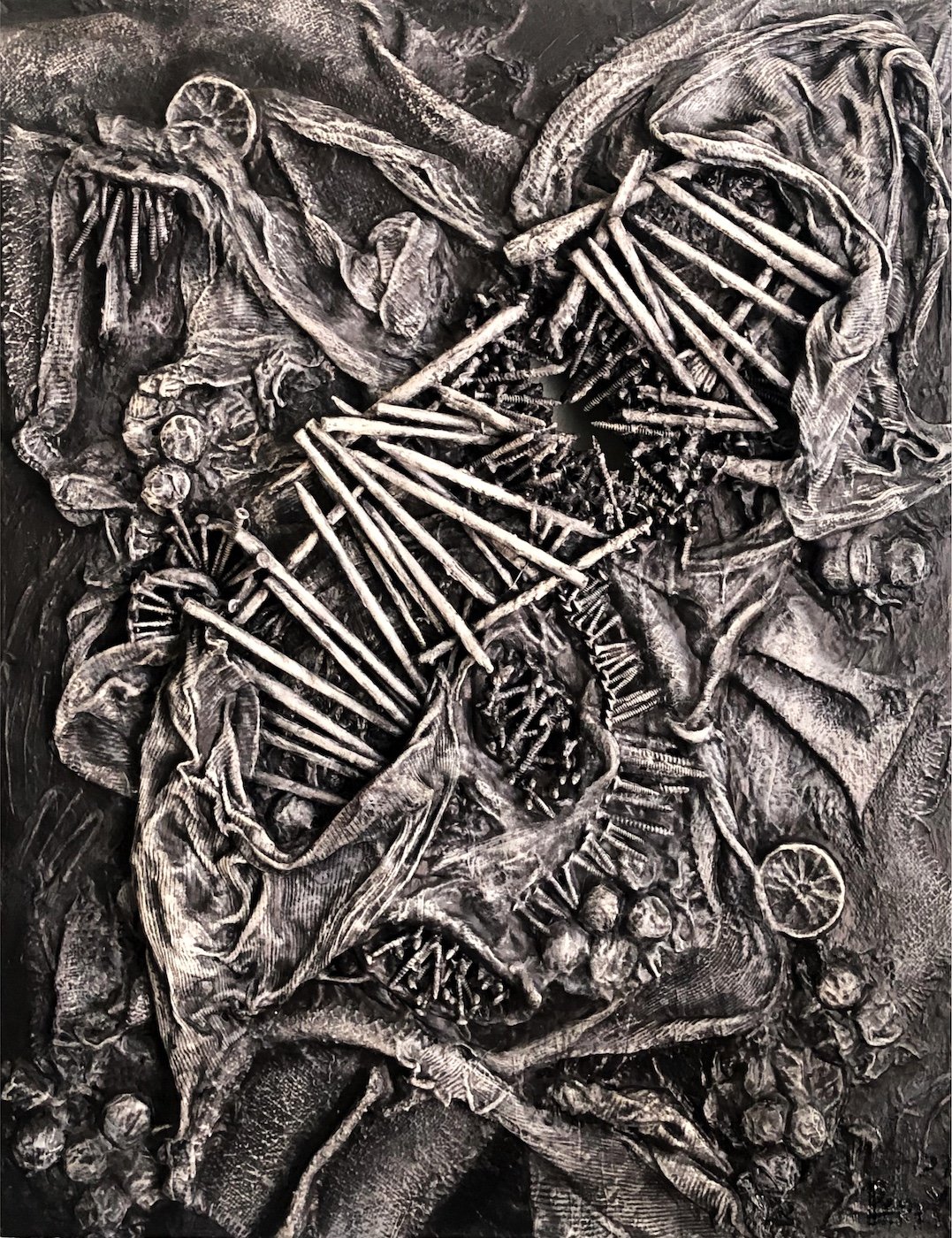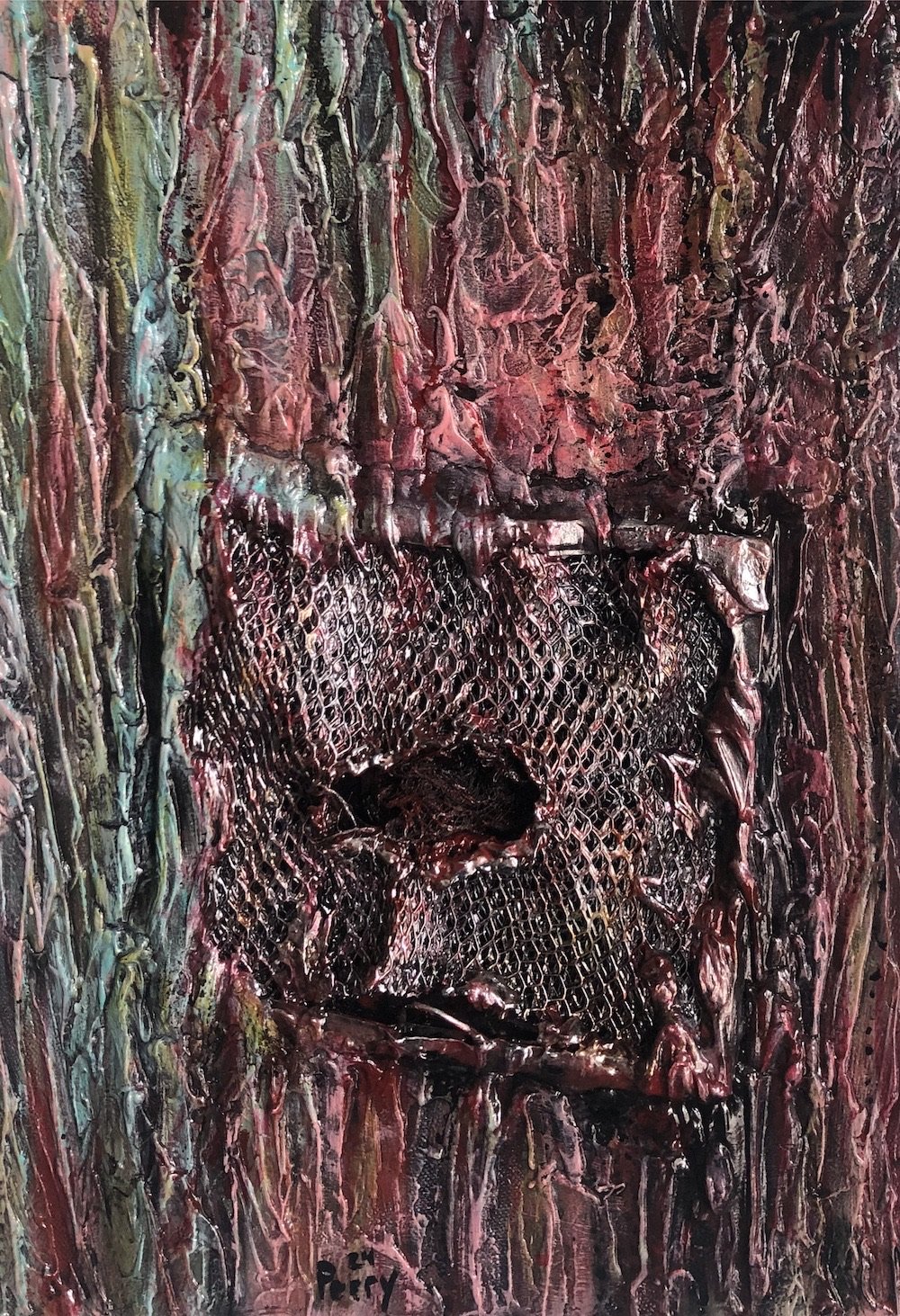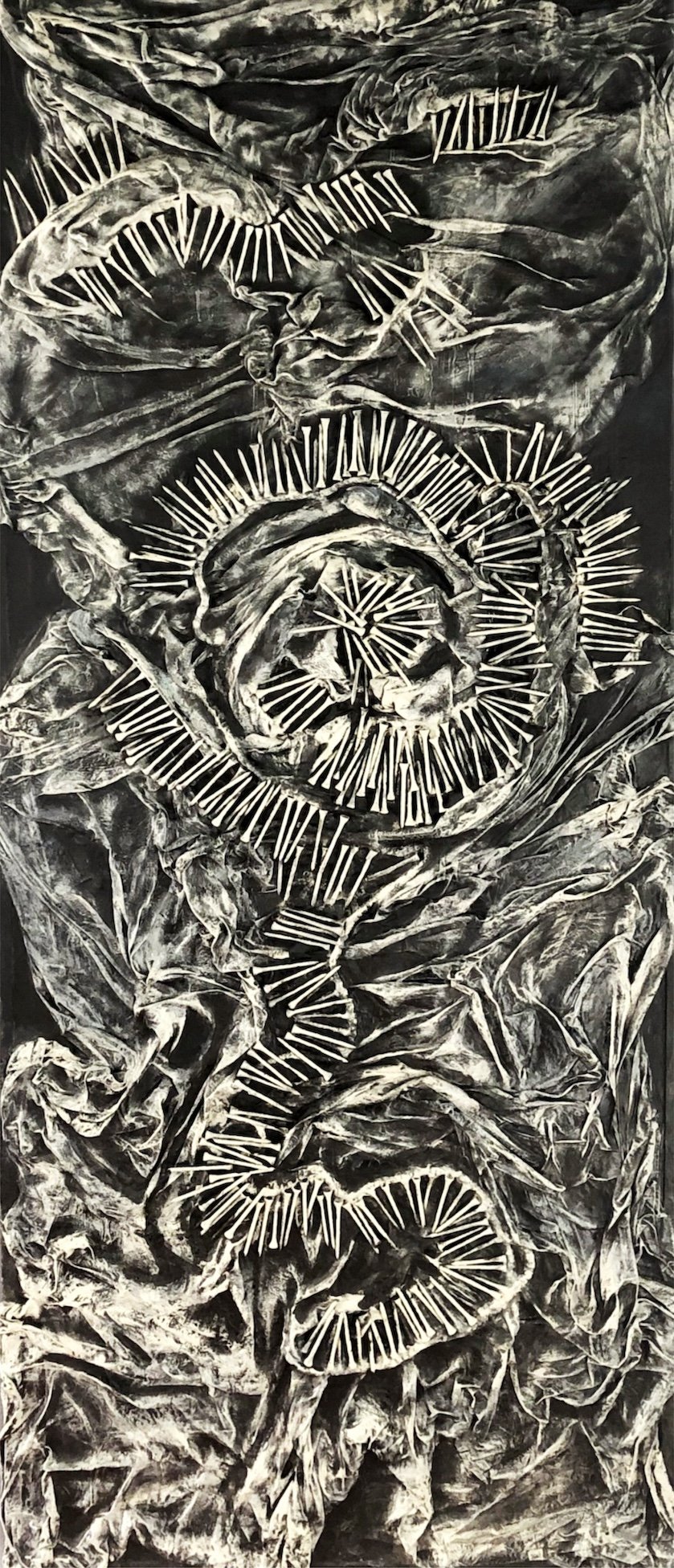Interview with artist Christian Scott Perry
Christian Scott Perry is an artist living in Rogers, Arkansas. His mixed media paintings incorporate commonly discarded objects into, what he describes as cathartic abstractions. More of Christian’s fascinating and evocative work can be found at his Instagram.


AAS: Christian, tell me about yourself. Are you originally from Arkansas?
CP: I’m originally from Dearborn, Michigan. My father worked for a railroad company, so we moved around a lot when I was a child. I became accustomed to being the new kid in school and growing up in the suburbs around metropolitan areas. We ended up moving to Rogers, Arkansas from New Jersey when I was ten years old. I spent a lot of time playing in the woods and hiking around the available countryside. It was definitely a change in landscape for me but also a change in the pace of life. I was isolated in a way that allowed for time by myself in the woods with my imagination running free. This is when I started to become fascinated by the integration of development and technology in nature. I saw some of my favorite trees knocked down and the habitats of animals displaced for pipes, roads and what we define as a society as progress. A defining childhood memory was seeing my clubhouse in the woods torn down to make way for a brand-new neighborhood. It was ironically a self-defining moment in my life as I knew the neighborhood I lived in had also been developed from woods. This is when I really started becoming aware of my own footprint on my life, the environment and the lives of others.
AAS: Were you creative as a kid?
CSP: I’ve always been creative and encouraged to create from an early age. My mother always made a huge point to have me in either private art instruction or some form of extracurricular art classes. I grew up in the 80’s and 90’s so the pop culture of that time especially the Action, Sci-Fi and Horror genres play a huge role in my art. Some of the biggest iconic influences for me would be H. R. Giger’s biomechanical aesthetic, Russell Mills’ work on Nine Inch Nails, The Downward Spiral, Tim Burton, Rob Zombie, the whole vibe of Brandon Lee in The Crow. Anything goth and steampunk! I also love The Little Mermaid and the whole story of isolation and longing for acceptance in a different world from the one you are currently living in. I tend to gravitate towards the weird, ambiguous, and oftentimes misunderstood.
I had private lessons with painter and ceramist Becky Christenson and she was an enormous influence on me. Stephanie Lewis, my college professor, was pivotal in introducing me to the art movement German Expressionism that is so influential to me. It was during my college art classes that I developed my three-dimensional style of painting utilizing found objects.
AAS: Tell me about your current series of work under the title Ecdysis: shedding my skin.
CSP: Ecdysis: shedding my skin is such an important series to me. Ecdysis is a metamorphic process in which an animal sheds its old skin. This series is my first art series I have displayed in over a decade. I painted all of these works while processing my mother’s death, a global pandemic, societal and political divisions, my divorce and my own personal mental health breakdown and journey through therapy and healing. It’s a series about accepting the traumas life can bring us and transforming them into tools of empowerment. Some of these paintings relate to the old wounds from my childhood, some relate directly to my mom’s wounds as she was unable to heal from her battle with rheumatoid arthritis. These are pieces that deal with the parts of life that oftentimes are easier to ignore. These are the shameful memories and parts of us that we carry but don’t acknowledge as parts of ourselves. It was so cathartic to work through some of the most incredibly difficult moments of my life.
AAS: You mentioned using found or ‘everyday’ objects in your art? Why is that important to you, especially in your current series?
CSP: I believe that there is something spiritual in the discarded and unwanted. Beauty can be found all around us if we pay attention. I want my art to speak on the disposable nature of our behavior and products. But even on a deeper level I want it to speak on how we, as a society and culture, discard and refuse to acknowledge parts of our own community, history, and a lot of times deep parts of ourselves. Even though something is “thrown away” doesn’t mean it disappears or is gone forever. Just like our past traumas are never gone even though we pretend that they might not exist. I want my repurposed objects to represent a message of purpose and redemption for the once discarded and forgotten. All of the objects tend to hold special meanings, some deeply personal like the bandages representing my mother’s health struggle.
AAS: I want to ask you first about Consumption. While the reference is literal, your depiction is somewhat startling. What is the story behind that image?
Consumption, 24” x 24”, mixed media with plastic cutlery and straws on canvas
CSP: Consumption is a piece I painted utilizing the leftover plastic cutlery from having food delivered during the pandemic. I had such an excessive amount of it leftover I decided I wanted to make a painting to speak on plastic consumption and our disposable culture. The cutlery is arranged to represent a flower symbolizing the growth of our consumption and the ambiguity between what is natural and what is artificial. The title Consumption is a reference to an impossible hunger that is impossible to sustain and a disastrous society of excess. It’s meant to be a critique and one that I reflected on personally examining my own “consumption”.
AAS: What is the significance of the paintbrushes used in Crossroads?
Crossroads, 40” x 30”, mixed media with paintbrushes and fabric on canvas
CSP: I love this question! The paintbrushes in Crossroads represent closed chapters of my life. Those brushes all at one point were my everyday studio companions and helped me paint previous paintings. Unfortunately, with wear and tear on the bristles my relationship with them and their role in my life changed. So much like old parts of ourselves or old relationships they are still a part of our story even if the roles they serve in our lives have changed. The painting is about having to make difficult decisions in the wake of these changed parts of ourselves and our relationships.
AAS: Has art always been an outlet for you to work through your emotions?
CSP: I would say art has always been an emotional outlet for me. I believe that creative expression is paramount for a healthy functioning society. Creativity when expressed, no matter the artform, allows for so much healing to take place. Definitely with the Ecdysis: shedding my skin series I have been using my art to work through emotions and cathartically process difficult parts of my past and myself. A lot of these pieces place a big influence on emotions and working through the heavy stuff we all carry with us. I feel so empowered now being able to process a lot of the parts of my past.
AAS: Dark Angel is an extraordinary interpretation of what I see as the Sacred Heart meets the Belly of the Beast. Tell me about it.
Dark Angel, 48” x 30”, mixed media with plastic cutlery and fitted sheets on wood
CSP: I love your interpretation on Dark Angel and the dichotomy between Sacred Heart and Belly of the Beast. Dark Angel is a painting representing the rise of the divine feminine within our world but also within myself. It’s directly a reference to a kundalini meditation experience I had in which I felt reborn. The piece is done on a repurposed wooden tabletop from Brazil and utilizes old paintbrushes, fitted sheets, and plastic cutlery. It’s about overcoming patriarchal society standards and embracing the divine feminine within our world and ourselves. A winged, mermaid goddess is the imagery I was thinking of while conceptualizing this piece. I believe that eventually a balance will be restored to the divine masculine and feminine and this painting is an homage to that.
AAS: I am old, and Night Terrors reminds me of the 1987 movie Hellraiser, which was a terrifying movie. Did you suffer from night terrors as a kid?
Night Terrors, 34” x 24”, mixed media with plastic cutlery and fitted sheets on canvas
CSP: I love the Hellraiser series so much and I am so happy Night Terrors reminds you of it. Yes, as a child I definitely suffered from really bad night terrors. I used to wake up in a pool of sweat, tangled in bedsheets trying to claw my way out of my own head. A lot of the nightmares were due to traumatic incidents in my childhood. I often found myself unable to even want to get in my bed and fall asleep. I used the fitted sheets and forks as direct reference to this memory. It speaks to in many cases the silent suffering children go through. I never realized until I was older and in therapy how sleep deprived my childhood was due to night terrors. This painting helped me work through so many of those unpleasant memories of my past.
AAS: Then there is Healing. Does this piece bring to closure the series?
Healing, 16” x 12”, mixed media with plastic thread on canvas
CSP: Healing is absolutely a piece meant to bring closure to the series. It’s a story about being emotionally torn apart but having the resilience to hold together. It’s an inspirational painting for me. It refers a lot to my personal work on healing from grief, shame and heartbreak. After my mother passed, I went through a period of serious depression and eventually a mental breakdown. It took years of hard work involving talk therapy, EMDR therapy, Reiki and Yoga therapy to heal. As a painting of closure, it’s about becoming something new and healed after trauma. Life can be incredibly challenging and Healing is a painting about healing the emotional wounds we carry.
AAS: You just exhibited your work at Mount Sequoyah Gallery in Fayetteville. What was that experience like?
CSP: The show at Mount Sequoyah was incredible! Huge shout out to fellow artist Shelley Mouber for curating the show and being one of the first people to really want to exhibit my art! I felt so honored to share such a personal collection of paintings that tell my story of loss, heartbreak and healing. It was my first show to display in over a decade and I could not have been more thrilled with the attendance and overall experience. After the initial show I went through a brief period of mild depression for about a week. It was such a huge emotional series and a big energy shift for me I think it took me a week to really process it. I was thrilled to be invited back by Mount Sequoyah to give a lecture on my Ecdysis: shedding my skin series. The lecture Paint your Nightmares: Transforming Trauma Through Art was very well received. I was able to talk about the series in detail with a Q&A at the end. It really brought a good closure to the series and for me emotionally.
AAS: Christian, where do you think your art is headed next?
CSP: I see myself only getting busier and busier with art. Last year I wasn’t even sharing any of my art and now with a lot of encouragement from amazing people I have two shows done and many more planned and on the way. Big shout out to David Gomez for really inspiring me to pursue my artistic dream! I just finished doing a mental health art event about shadow work at ARt deCentrale in downtown Springdale, Arkansas. Thank you to Psychology & Counseling Associates and Allan Paulose the gallery owner for arranging the important event highlighting mental health and art. Coming up in August I’m so incredibly excited to be exhibiting with Northwest Arkansas artists Jesse Weegens and Tom Day! I love that this area is becoming so art focused and investing in it. There are so many amazing things on the horizon for not just me but our whole art community in Northwest Arkansas! Thank you also Phil for taking the time to spotlight creatives like me.






